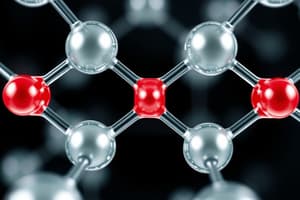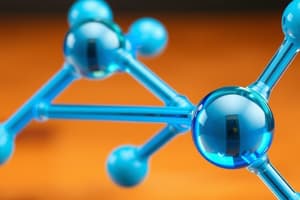Podcast
Questions and Answers
What is a covalent bond?
What is a covalent bond?
- A bond formed between a metal and a non-metal
- A bond formed between two metals
- A chemical bond formed by the transfer of electron pairs
- A chemical bond formed by the sharing of electron pairs (correct)
How are electrons involved in a covalent bond?
How are electrons involved in a covalent bond?
- They are shared between atoms (correct)
- They are not involved in covalent bonds
- They are transferred from one atom to another
- They are donated to the nucleus
What types of elements typically form covalent bonds?
What types of elements typically form covalent bonds?
- Non-metal elements (correct)
- Alkali metals
- Metal elements
- Noble gases
What type of bond is formed through the sharing of electrons?
What type of bond is formed through the sharing of electrons?
In a covalent bond, how are the electrons shared?
In a covalent bond, how are the electrons shared?
Which type of bond is characterized by the formation of molecules?
Which type of bond is characterized by the formation of molecules?
Flashcards are hidden until you start studying
Study Notes
Covalent Bonds
- A covalent bond is a type of chemical bond that involves the sharing of electrons between atoms.
- Electrons are involved in a covalent bond as they are shared between atoms to form a bond.
- Non-metal elements, such as carbon, nitrogen, and oxygen, typically form covalent bonds.
- Covalent bonds are formed through the sharing of electrons between atoms.
- In a covalent bond, the electrons are shared equally or unequally between atoms to form a molecule.
- Covalent bonds are characterized by the formation of molecules, which are groups of atoms bonded together through covalent bonds.
Studying That Suits You
Use AI to generate personalized quizzes and flashcards to suit your learning preferences.




